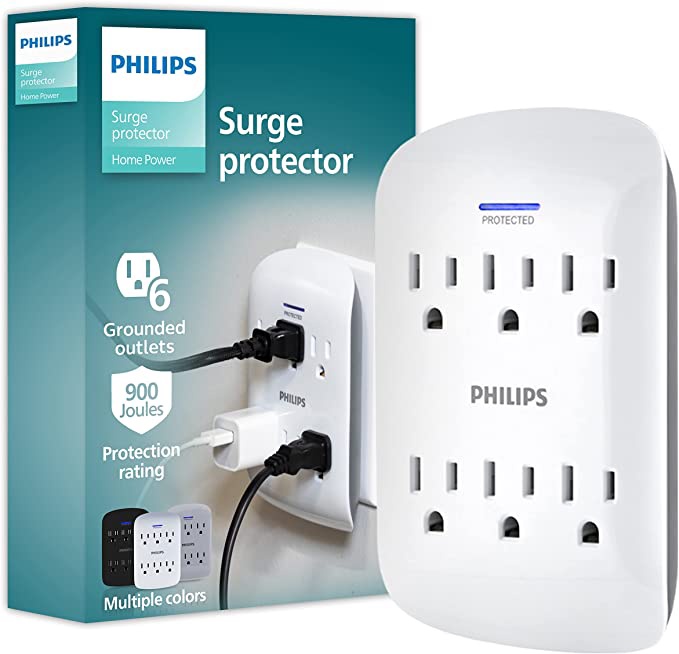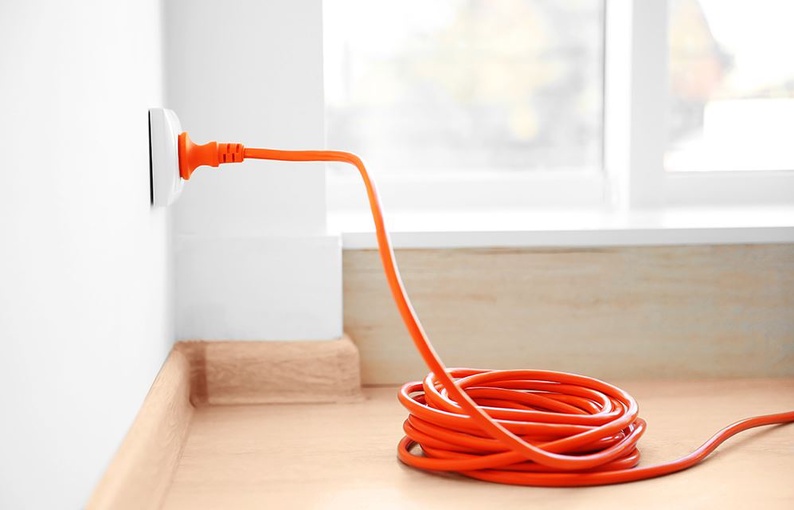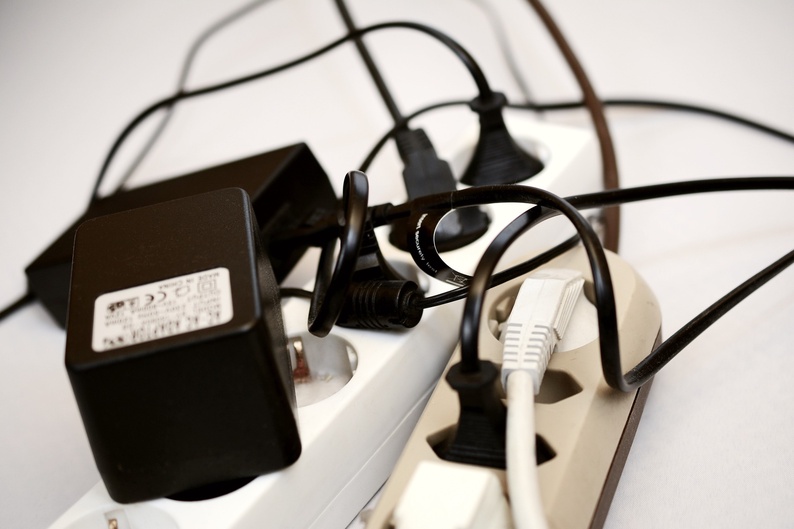Choosing between a surge protector and an extension cord can be confusing when protecting your electronics. In this article, we’ll delve into the differences between these two devices, their functions, and which is best for safeguarding your valuable electronics.
What is a Surge Protector?
A surge protector is a device designed to protect your electronics from power surges, which are sudden increases in voltage that can damage or destroy sensitive equipment. These surges can occur due to lightning strikes, power grid fluctuations, or other electrical disturbances.

Surge protectors work by detecting and managing excess voltage, safeguarding your devices from potential damage caused by power surges. The internal components of a surge protector work together to ensure that your electronics remain safe and functional during voltage fluctuations.
These are some of the ways a surge protector works:
- Detection of voltage spikes: When a power surge occurs, the surge protector senses the increase in voltage. This is typically done using components called metal oxide varistors (MOVs) or gas discharge arrestors (GDAs). These components are sensitive to voltage levels and respond rapidly to fluctuations.
- Diverting excess voltage: Once the surge protector detects a voltage spike, it redirects the excess voltage away from your devices. The MOVs or GDAs bridge the hot (live) wire and the grounding wire in the surge protector. During regular operation, the MOVs or GDAs remain non-conductive, allowing electricity to flow uninterrupted through the hot wire to your devices.
- Clamping voltage: During a power surge, the MOVs or GDAs become conductive, creating a temporary path for excess voltage to flow into the grounding wire. This process is known as “clamping,” and it effectively limits the voltage that reaches your connected devices. Clamping voltage is a crucial specification in surge protectors, as it determines the maximum voltage the device will allow to pass through to your electronics.
- Resetting after a surge: Once the power surge has passed, the surge protector’s components return to their non-conductive state, allowing electricity to flow normally to your devices. High-quality surge protectors can handle multiple power surges throughout their lifespan. However, it’s essential to remember that these components can degrade over time, and the surge protector may eventually lose its ability to protect your devices effectively.
Investing in a high-quality surge protector is a smart decision to ensure your devices’ longevity and proper functioning.
What is an Extension Cord?
An extension cord is a length of electrical cable with a plug at one end and one or more sockets at the other end. Its primary function is to extend the reach of an electrical outlet, allowing you to connect multiple devices to a single power source that might be too far away from the devices you’re trying to power.

Extension cords work by providing a simple pass-through for electricity. They do not have any built-in protection against power surges or other electrical disturbances. While they can help you power multiple devices simultaneously, they offer no safeguard against voltage fluctuations.
The most significant difference between surge protectors and extension cords is their ability to shield your electronics from power surges. Surge protectors offer this protection, while extension cords do not.
Understanding Power Surges
Power surges are brief but intense spikes in electrical voltage that can cause severe damage to your devices. They can originate from various sources, such as lightning strikes, power grid switching, and large appliances turning on or off. The damage caused by a power surge can range from minor component wear to complete device failure.
The ability of a surge protector to handle and absorb the energy from power surges is measured in joules, the unit of energy. In the context of surge protectors, a higher joule rating indicates a greater capacity to absorb and dissipate the energy from power surges, offering better protection for your connected devices.
The joule rating is an essential specification when evaluating surge protectors and power surges. A higher joule rating generally means that the surge protector can handle more powerful or frequent surges, making it more suitable for protecting sensitive and expensive electronics.

Here’s a rough guideline for selecting a surge protector based on its joule rating:
- Low joule rating (up to 1000 joules): Suitable for less sensitive devices, such as lamps or small appliances. These surge protectors provide basic protection but may not be adequate for expensive or delicate electronics.
- Medium joule rating (1000-2000 joules): A good choice for standard home electronics, such as televisions, gaming consoles, and desktop computers. These surge protectors offer a decent level of protection for everyday use.
- High joule rating (2000+ joules): Recommended for expensive and sensitive electronics, including high-end home theater systems, advanced gaming setups, or professional-grade office equipment. These surge protectors provide the highest level of protection and are designed to withstand powerful and frequent power surges.
How surge protectors handle power surges and overload
Surge protectors are designed to absorb and redirect excess voltage during a power surge. They contain metal oxide varistors (MOVs) or similar components that quickly respond to voltage spikes, limiting the voltage that reaches your connected devices. By doing so, surge protectors protect your electronics from the harmful effects of power surges.
Surge protectors also often come with built-in overload protection, which prevents your devices from drawing more current than the protector can handle. This feature helps avoid damage to both the surge protector and your electronics. In contrast, extension cords typically lack this safety feature, increasing the risk of overloading and damaging your devices.
A surge protector’s ability to absorb energy diminishes with each surge it encounters. Over time, the surge protector’s effectiveness can degrade, and it may no longer provide adequate protection for your devices. Many surge protectors have an indicator light or alarm that signals when the device’s protection capacity has been exhausted, at which point it should be replaced.
Capacity Management
It’s essential to be aware of the capacity of your surge protector or extension cord to avoid overloading. Overloading can cause excessive heat, leading to insulation breakdown, damage to connected devices, or even electrical fires. Always check the rated capacity of your surge protector or extension cord and ensure that the combined power draw of your connected devices does not exceed this limit.

Here are some things to look for when validating the capacity of these devices:
Check device wattage: Look for labels or stickers on your electronic devices that indicate their power consumption, usually expressed in watts (W). You can often find this information on the bottom or back of the device, the user manual, or the manufacturer’s website.
Calculate total power draw: Add up the wattage of all devices you plan to connect to the surge protector or extension cord. This total will give you an estimate of the combined power draw. Remember that some devices may have variable power consumption depending on usage, so it’s crucial to account for peak power draw when calculating the total.
Compare to rated capacity: Check the rated capacity of your surge protector or extension cord, which is usually indicated in amperes (A) on the packaging or label. Ensure that the combined power draw of your devices does not exceed the rated capacity. For example, if your surge protector has a rated capacity of 12A, and your calculated total current draw is 10A, your devices should be safe to use with the surge protector. Check the info block below for a quick way to safely calculate the total current draw.
Allow for a safety margin: To reduce the risk of overloading further, it’s a good practice to leave a safety margin between the combined power draw and the rated capacity of your surge protector or extension cord. A safety margin of 20% is generally recommended. For example, if your surge protector has a rated capacity of 12A, aim to keep your total current draw below 9.6A (12A x 0.8 = 9.6A).
To compare the combined power draw to the rated capacity of your surge protector or extension cord, you may need to convert watts to amperes (A). You can do this using the formula: Amperes = Watts / Volts.
In most countries, the standard voltage is either 110-120V or 220-240V. For example, if your total power draw is 1200W and your household voltage is 120V, the total current draw would be 1200W / 120V = 10A.
Which One is Right for You?
It can be challenging to decide between a surge protector and an extension cord, as they both serve different purposes. However, it’s crucial to understand the differences between these devices to ensure that you’re using the right one for your needs.
Let’s explore some of the factors to consider when choosing between a surge protector and an extension cord and some examples of good use cases for each.
When in doubt, always consider using a surge protector instead of an extension cord. Use extension cords only when necessary, and avoid using them for devices that must be active for extended periods.
When to Use a Surge Protector
A surge protector is essential for safeguarding expensive electronics, as these devices are susceptible to damage from power surges. Investing in a surge protector is crucial to shield them from potential harm.
Here are some situations and devices that benefit from using a surge protector:
- Sensitive electronics: Devices such as computers, televisions, gaming consoles, and home theater systems are highly susceptible to damage from power surges and require additional protection.
- Examples: desktop computers, laptops, smart TVs, gaming consoles (e.g., PlayStation, Xbox, Nintendo Switch), audio and video receivers, and surround sound systems.
- Office equipment: Work-related electronics, including printers, scanners, and copiers, can be expensive to replace and should be protected from voltage spikes.
- Examples: all-in-one printers, scanners, fax machines, and desktop computers.
- Network and communication devices: Equipment responsible for maintaining internet connectivity and communication can be damaged by power surges, causing interruptions in service.
- Examples: routers, modems, and VoIP devices.
- Home automation and security systems: These systems control various aspects of your home and should be protected to ensure consistent and reliable operation.
- Examples: smart thermostats, security cameras, and smart home hubs.
- Long-term power needs: Surge protectors are suitable for long-term power requirements, as they can handle multiple power surges throughout their lifespan.
- Examples: desktop computers, home theater systems, or your christmas lights.
- Unattended devices: Surge protectors are ideal for devices left unattended for extended periods that might produce an electric or fire hazard if left unattended.
- Examples: space heaters, air conditioners, and dehumidifiers.
When to Use an Extension Cord
Extension cords are suitable for less sensitive devices that do not require protection against power surges. However, remember that extension cords should be used sparingly and as a temporary solution, as overloading them can cause electrical fires or damage your devices.
Here are some situations and devices that can safely use an extension cord:
- Lighting solutions: Lamps and other lighting devices typically do not require surge protection and can be powered using extension cords.
- Examples: table lamps, floor lamps, and short-term light fixtures.
- Small appliances: Many small kitchen and household appliances do not need protection from power surges and can be safely connected to extension cords.
- Examples: coffee makers, toasters, electric kettles, and portable fans.
- Gardening and outdoor tools: Power tools and outdoor equipment generally do not require surge protection, making extension cords suitable for powering them.
- Examples: electric lawnmowers, leaf blowers, and hedge trimmers.
- Temporary power needs: Extension cords can be used for short-term power requirements during events or activities that do not involve sensitive electronics.
- Examples: powering decorations during parties, providing temporary lighting for a workspace, or charging a cordless drill during a DIY project.
Remember that choosing the right type of extension cord for your specific needs is essential, considering factors such as the cord’s length, gauge, and maximum current capacity. Always follow the manufacturer’s guidelines and safety precautions to avoid overloading the extension cord and causing potential hazards.
Frequently asked questions
What is a surge protector?
A surge protector is a device designed to protect your electronics from power surges, which are sudden increases in voltage that can damage or destroy sensitive equipment. These surges can occur due to lightning strikes, power grid fluctuations, or other electrical disturbances.
What is an extension cord?
An extension cord is a length of electrical cable with a plug at one end and one or more sockets at the other end. Its primary function is to extend the reach of an electrical outlet, allowing you to connect multiple devices to a single power source that might be too far away from the devices you’re trying to power.
What is the difference between a surge protector and an extension cord?
The most significant difference between surge protectors and extension cords is their ability to shield your electronics from power surges. Surge protectors offer this protection, while extension cords do not.
How do surge protectors work?
Surge protectors work by detecting and managing excess voltage, safeguarding your devices from potential damage caused by power surges. The internal components of a surge protector work together to ensure that your electronics remain safe and functional during voltage fluctuations.
How do extension cords work?
Extension cords work by providing a simple pass-through for electricity. They do not have any built-in protection against power surges or other electrical disturbances. While they can help you power multiple devices simultaneously, they offer no safeguard against voltage fluctuations.
What is a power surge?
Power surges are brief but intense spikes in electrical voltage that can cause severe damage to your devices. They can originate from various sources, such as lightning strikes, power grid switching, and large appliances turning on or off. The damage caused by a power surge can range from minor component wear to complete device failure.
How do I calculate the combined power draw of all my devices plugged to an outlet?
To calculate the combined power draw of a surge protector, you need to know the power rating of each device connected to it. You can then add up the power ratings of all the devices to determine the total power draw of the surge protector. You can use the formula: Amperes = Watts / Volts


